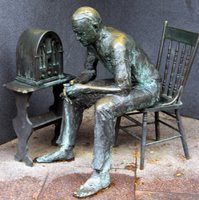« Home | PWC says media spending to reach $1.8 trillion in ... »
Pondering the future of radio
 "Radio" today is really just transferred audio. In the past, we only received radio from programming broadcast by stations via a transmitter tower. Now radio also includes online streaming, downloading, podcasting, timeshifting, file sharing and more things digital...as well as traditional broadcast radio stations transmitting to your traditional receiver.
"Radio" today is really just transferred audio. In the past, we only received radio from programming broadcast by stations via a transmitter tower. Now radio also includes online streaming, downloading, podcasting, timeshifting, file sharing and more things digital...as well as traditional broadcast radio stations transmitting to your traditional receiver.
Although traditional radio no longer has the transmitted audio platform exclusively, radio -- on the whole -- is way better. Radio, that is, including both the analog and the digital platforms. We all are listening to more total "radio" than ever before. So what is this doing to traditional radio?
The trend for media toward more user convenience, personal control, context-selected content and new community interactions of shared experiences continues to grow. Several new press releases on radio take a look at the current state of radio and its near-future. At the beginning of the week, RADAR, Arbitron's radio network and national audience measurement service announced in its new national study that radio reaches 93 percent of all people 12 and older in a typical week. 81% of all people 18 and older listened to radio while in their cars and 25 percent listened to radio at work. And more than 183 million people, or 74 percent of all people 12 and older+, tune to radio on Saturday or Sunday.
At the beginning of the week, RADAR, Arbitron's radio network and national audience measurement service announced in its new national study that radio reaches 93 percent of all people 12 and older in a typical week. 81% of all people 18 and older listened to radio while in their cars and 25 percent listened to radio at work. And more than 183 million people, or 74 percent of all people 12 and older+, tune to radio on Saturday or Sunday.
Despite all the competitive advances in digital radio/audio, morning drive radio and afternoon drive radio are still radio's "prime times", with about 190 million Americans listening to week radio to start and end their workdays. Of course, radio still frustrates listeners with generic formats, reduced creativity/uniqueness and too many commercials...but the point is this: radio remains a strong and important form of daily entertainment and information.
However, radio's image has taken a hit these last few years, replaced by more "sexy" forms of digital audio on the iPod and through the Internet. So, if radio usage remains strong with consumers despite weakened marketing image, how are the experts viewing the future of radio? The annual Radio Symposium took place in New York yesterday and a number of presentations gave some fresh insight for those pondering the future of radio.
The annual Radio Symposium took place in New York yesterday and a number of presentations gave some fresh insight for those pondering the future of radio.
Fewer and Shorter = Less. First, the broadcast data firm firm Media Monitors revealed a new study saying radio stations across the country shaved off a full minute of commercials per hour, reduced the total amount of ads played in a typical hour from 9 spots to 8.4, and shifted from fewer 60 second to shorter 30 second spots (1 of 5 commercials now heard are 30 second spots).
Overall, radio now has shorter breaks, fewer units and fewer spots per hour. Of course, that's not true for every format and that's certainly not true for markets with the largest ad revenues (Los Angeles, New York on down). Talk radio still regularly averages 16 minutes of ads an hour, including some stations selling more than 20 minutes an hour. However, nationally, as a media trend, total average spot loads are going down. Finally.
Meanwhile, Bridge Ratings explored the impact of digital media on radio with a new survey on listeners, asking how different types of digital media affected their radio habits. According to their study, the competing mediums are taking a bite out of regular radio, with an overall decline in the total time spent listening. Many respondents did say that other mediums cause them to listen to the radio more often, especially podcasting (58 percent), P2P file sharing (51 percent) and MP3 players (42 percent). However, radio is losing out mainly to Internet radio, with 55 percent saying it cause them to listen to less traditional radio.
Some formats are affected more than others. Not surprisingly, Rock and Alternative lose the most listenership to other mediums (-15 percent), followed by CHR (-12 percent) and News/Talk (-10 percent) while other (Adult Hits, AC) spend more time with terrestrial radio because of digital media. Of course, Rock and Alternative formats are the formats most rapidly disappearing from airwave radio, due to sample problems with 18-34 year men leading to lowered ratings. Continuing at the symposium, Paul Heine of Billboard said tough question were being asked by Wall Street (whose love affair with radio seemed to end shortly after 9/11). Bear Sterns showed radio stocks trending down for 80% of 2006 and said radio hasn't been normal for the past 10 years. Radio group Cumulus chairman and CEO Lew Dickey said "radio provides a safe harbor in the digital convergence world."
Continuing at the symposium, Paul Heine of Billboard said tough question were being asked by Wall Street (whose love affair with radio seemed to end shortly after 9/11). Bear Sterns showed radio stocks trending down for 80% of 2006 and said radio hasn't been normal for the past 10 years. Radio group Cumulus chairman and CEO Lew Dickey said "radio provides a safe harbor in the digital convergence world."
For sure, radio is not going away. It's just evolving. Some on Wall Street say "with good management, radio companies can create better-than-industry-average returns." As for looking ahead, some predict satellite and Internet radio "will settle in the next few years and the radio industry will return to more of an even keel."
Billboard article here
Media Monitors press release here
RADAR press release here
posted by Unknown @ Wednesday, June 28, 2006,
![]()
![]()
1 Comments:
- At 5:13 PM, said...
-
Having lived in Boca Raton for several years, listening to the 103.1 WIRK has become a daily ritual for me. I start my day with a cup of coffee and a side of the 103.1 ‘Morning Show’ with DJ Tiny. For the rest of the day I enjoy great tracks by some of my favorite artists. The station’s great selections of Country music adds so much needed groove to my day! The 103.1 is a stay at home mom’s best source for great
entertainment. Tune in today or stream online at www.wirk.com!
















